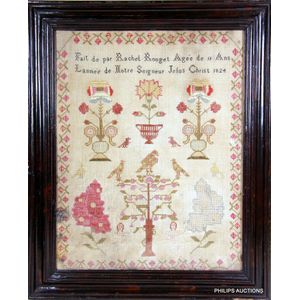Limoges Enamel Plaques by Charles Dotin, 20th Century
You must be a subscriber, and be logged in to view price and dealer details.
Subscribe Now to view actual auction price for this item
When you subscribe, you have the option of setting the currency in which to display prices to $Au, $US, $NZ or Stg.
- Arabesque - The arabesque pattern is an ornamental design that features flowing, curving lines and elaborate geometric shapes. It is inspired by the art and architecture of the Islamic world and was developed at Fontainebleu France in the mid 16th century. Its use was spread through published engravings, and it is characterized by its intricate and highly decorative nature. The arabesque pattern is created using a repetitive motif that is repeated and interwoven to create a cohesive design. It was used as a form of decoration in art, architecture, textiles, pottery, furniture and ceramics and it is often used to add a sense of grandeur and sophistication to a design. The arabesque pattern is admired for its beauty and complexity, and it continues to be used in a wide range of decorative contexts today.
- Attributed - A cataloguing term where the item in the opinion of the cataloguers, is a of the period of the artist, craftsman or designer, and which probably in whole or part is the work of that person.
- Foliate - Decorated with leaves or leaf-like forms.
This item has been included into following indexes:
- Limoges (France)
- plaques - ceramic, European unmarked 35
Visually similar items

A pair of gilt framed copperplate engravings, fresco designs for the Vatican, after the originals by Raphael Sanzio d'Urbino (1483-1520) published in Rome between 1772 and 1777, engraver John Ottavini (1738-1808), after drawings by Cai Savorelli (fl.1750-1

An antique French sampler, 1824, by Rachel Rouget, aged eleven, a cross stitch and pulled work sampler in muted colours on broad weave linen with fruiting trees, flowers, pot plants, birds and two figures. Height 50.5 cm, width 41 cm

Tapestry. 18th century silk & natural Dyes, flowers Reframed 1995, 25.5 x 22.5 cm, (signs of water damage to the background)

Still life of roses, oil on board, unsigned, approx 32 cm x 64 cm
